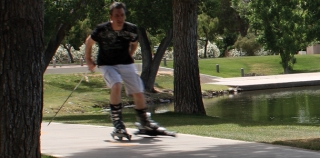All of these questions also had to be asked by Doug Lucht, founder of StreetSki, until he found a way to combine his passion for skiing with the versatility of inline skates. But how can this be done?
It has always been said that one of the best training sports for skiing is inline skating since the movements and positions of the body are very similar. If we modify a skate so that its response is as similar as possible to a ski, we have a StreetSki. What has been done is to lengthen the flange where the wheels are mounted up to about 70 centimeters (depending on the model) and a conventional ski binding has been placed on it. This is very important since it is used with the boots we normally use for skiing, providing almost identical sensations.

The greatest benefits that we can obtain, apart from the general cardiovascular improvement, consist of the specific use of the technique and muscle groups that we will later use for skiing, with which we can reduce the possibility accidentso common at the beginning of the season due to not being in adequate physical shape. It is also the ideal way to "break in" a boot before putting it on the slopes, which will save us a few days of adaptation to the new boots, even allowing us to make modifications to the shell or liner and avoid later pain.
Furthermore we do not depend on snowfall, nor do we have to make long trips, or pay expensive ski passes. It can be used on any surface, paved or not, flat or sloping, with or without poles, they can be used by people of any age, in short, an invention designed by skiers for skiers.
The speed that can be reaching is no joke either. In downhill competitions, people usually reach up to 80 kilometers per hour, although the first speed record, held by Doug Lucht, is 101 kilometers per hour!, which allowed him to enter the Guinness Book of Records. Curiously, he achieved this record in 1998 on the same day he turned 30.

Models
All of them have 80 millimeter wheels and 78A hardness, although the downhill and all-terrain wheels are specific for these modalities. By default they are supplied with Marker 28 bindings, of different colors depending on the model.
- StreetSki Slalom. Intended for short turns, it has a much lighter, shorter design (70 centimeters compared to 87 for the rest of the models), aggressive and easy to handle. By far the best seller of all.
- StreetSki Giant Slalom. Its six wheels make it very stable at high speed, also favored by its greater length. It can be mounted with all-terrain wheels.
- StreetSki Downhill. Model prepared to reach the highest speeds. It is fitted from the factory with Hyper Shock competition wheels that have been tested by Team StreetSki at more than 95 kilometers per hour.
- StreetSki Extreme Terrain. This model was initially designed to be used on the lifts that operated in ski resorts during the summer and were only used for mountain bikes. It has special wheels for field use and the frame is very flexible.
- How do you go up the slopes?
- How do you stop?

- Protections?
- Does it take a long time to learn?
As in all things in life, we must know where our limits are. Just like in skiing, the perfect slope is the one on which everyone feels comfortable. The most common thing is to start flat until we get the hang of it, and gradually increase the difficulty.
Just think about one thing: a skier on average skis about 10 days per year. With StreetSki you could do the remaining 355.












